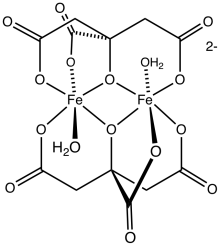Iron(III) citrate
Ferric citrate or iron(III) citrate describes any of several complexes of trivalent iron (Fe3+
) and a trivalent and any of several conjugate bases derived from citric acid. Most of these complexes are orange or red-brown solid, slightly soluble in hot water yielding an orange or orange-yellow solution at pH < 2.0.[1][2] The solution becomes green at pH > 2.0.[2]
| Names | |
|---|---|
| IUPAC name
iron(3+) 2-hydroxypropane-1,2,3-tricarboxylate | |
| Identifiers | |
3D model (JSmol) |
|
| ChEBI | |
| ChemSpider | |
| ECHA InfoCard | 100.020.488 |
PubChem CID |
|
| UNII | |
CompTox Dashboard (EPA) |
|
| |
| |
| Properties | |
| C6H5FeO7 | |
| Molar mass | 244.944 g·mol−1 |
| Appearance | dark orange-red brown solid[1] |
| ~5 g/l in water | |
Except where otherwise noted, data are given for materials in their standard state (at 25 °C [77 °F], 100 kPa). | |
| Infobox references | |
Ferric citrates play important roles in the metabolism of iron by living organisms. Citrate anions are released by plant roots and some microorganisms in order to extract iron from insoluble compounds in the soil, such as ferric hydroxide, and form soluble ferric citrates that can be absorbed by the organism.[3]
Ferric citrate is used in medicine to regulate the blood levels of iron in patients with chronic kidney disease on dialysis. It acts by forming an insoluble compound with phosphate present in the diet and thus reducing its uptake by the digestive system.[4]
Structure

Ferric citrate easily forms coordination complexes,[5][6] oligomers, and polymers. Thus it is not a single well-defined compound, but a family of compounds, all with the same basic formula and many different structures.[3]
This complexity extends to solutions, where various forms can coexist in equilibrium.[3][7] At physiological pH, ferric citrate forms an insoluble red polymer.[3] In other conditions, it forms anionic complexes like [Fe
2C
6H
4O
7]2(H
2O)2]2−.[3] In the present of excess citrate anions, the iron forms negatively charged complexes like [Fe(C
6H
4O
7)2]5−[3] and [Fe
9O(C
6H
4O
7)8(H
2O)3]7−.[8]
Preparation
Ferric citrate can be prepared by adding a stoichiometric amount of iron(III) sulfate tetrahydrate to a solution of citric acid and sodium hydroxide at pH 3.0. The salt can be precipitated by adding ethanol to the solution.[2]
Chemical properties
Photoreduction
The Fe3+
ion in ferric citrate (as in many iron(III) carboxylates) is reduced by exposure to light,[9] especially blue and ultraviolet, to Fe2+
(ferrous) ion with concomitant oxidation of the carboxyl group adjacent to the hydroxyl, yielding carbon dioxide and acetonedicarboxylate:
- 2Fe3+
+ R2-C(OH)-CO−
2 → 2Fe2+
+ R2-C=O + H+
+ CO
2
where -R represents the group -CH
2CO−
2. This reaction is not observed at pH < 1.5 or pH > 5.0, or in aprotic water-free solvents such as acetonitrile. In water, it has maximum quantum efficiency around pH = 2.9. It can be observed even in the solid state.[2]
This reaction plays an important role in plant metabolism: iron is carried up from the roots as ferric citrate dissolved in the sap,[10] and photoreduced in the leaves to iron(II) that can be transported into the cells.[2]
See also
References
- Sigma-Aldrich: Product Specification - Iron(III) citrate, technical grade. Accessed on 2017-03-09.
- Harmon B. Abrahamson, Ahmad B. Rezvani, J. George Brushmiller (1994): "Photochemical and spectroscopic studies of complexes of iron(III) with citric acid and other carboxylic acids". Inorganica Chimica Acta, volume 226, pages 117-127. doi:10.1016/0020-1693(94)04077-X
- Pierre, J. L.; Gautier-Luneau, I. (2000). "Iron and Citric Acid: A Fuzzy Chemistry of Ubiquitous Biological Relevance". Biometals. 13: 91–96. doi:10.1023/A:1009225701332.
- Julia B. Lewis, Mohammed Sika, Mark J. Koury, and others (2015): "Ferric Citrate Controls Phosphorus and Delivers Iron in Patients on Dialysis", Journal of the American Society of Nephrology, volume 26, issue 2, pages 493-503. doi:10.1681/ASN.2014020212
- Xiang Hao, Yongge Wei, Shiwei Zhang (2001): "Synthesis, crystal structure and magnetic property of a binuclear iron(III) citrate complex". Transition Metal Chemistry, volume 26, issue 4, pages 384–387. doi:10.1023/A:1011055306645
- I. Shweky, A. Bino, D. P. Goldberg, S. J. Lippard (1994): "Syntheses, structures, and magnetic-properties of 2 dinuclear iron(III) citrate complexes". Inorganic Chemistry, volume 33, issue 23, pages 5161-5162. doi:10.1021/ic00101a001
- Andre M. N. Silva, XiaoLe Kong, Mark C. Parkin, Richard Cammack and Robert C. Hider (2009): "Iron(III) citrate speciation in aqueous solution". Royal Chemical Society, Dalton Transactions, pages 8616-8625. doi:10.1039/B910970F
- Avi Bino, Itzhak Shweky, Shmuel Cohen, Erika R. Bauminger, and Stephen J. Lippard (1998), "A novel nonairon(III) citrate complex: A 'ferric triple-decker'". Inorganic Chemistry, volume 37, issue 20, pages 5168–5172. doi:10.1021/ic9715658
- Wu Feng and Deng Nansheng (2000): "Photochemistry of hydrolytic iron (III) species and photoinduced degradation of organic compounds: A minireview". Chemosphere, volume 41, issue 8, pages 1137–1147. doi:10.1016/S0045-6535(00)00024-2
- Rubén Rellán-Álvarez, Justo Giner-Martínez-Sierra, Jesús Orduna, and others (2010): "Identification of a tri-iron(III), tri-citrate complex in the xylem sap of iron-deficient tomato resupplied with iron: New insights into plant iron long-distance transport". Plant Cell Physiology, volume 51, issue 1, pages 91-102. doi:10.1093/pcp/pcp170